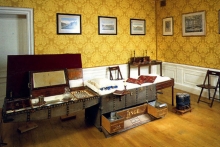The history of the appearance of transforming furniture

12 January 2021
The problem of lack of free space has worried mankind since very ancient times, and this pushed to new inventions. Gradually, over time, furniture elements appeared that could be folded and unfolded.
In this article, we will travel through the pages of history and conduct a small "investigation", find out how this furniture appeared, and trace its development history to the present day. Transforming furniture has become commonplace quite recently, but this does not mean that its history is pale and uninteresting.
The struggle for centimeters of space appeared a long time ago, but along with free space, people also needed comfort, which was and is achieved through high-quality and comfortable furniture.
So let's go back in time to find out how and when this useful and versatile transformable furniture came into being.
Such furniture existed in the ancient world, namely, folding chairs from Egypt and ancient Roman curtain chairs can be considered the first transformers. The mechanism of such furniture was very simple, but nowadays the oldest technology is often used. The mechanism consists of crossed legs, of which there were two pairs, and in the middle they were connected by a nail.
Furniture transformers 17-18 st.
The era that replaced the Middle Ages gave humanity a lot of new and interesting things, among these innovations was furniture that could rotate.
In the 17th century, the so-called "birdcage" appeared - this is a transforming table with a raised table top. In between meals, he was pressed against the wall so that he did not take up space and did not interfere. Then a seat was attached to such a table - this is how a real transforming furniture turned out.
A hundred years have passed, and mankind has invented another transformer - a symbiosis of a chair and a library ladder. The mechanism was also quite simple: the back of the chair reclined, and its lower part became the top rung of the stairs.
The next stage in the development of furniture transformers was the emergence of various mechanisms that make it possible to build furniture into secret drawers or sections.
The 19th century is the century of industrialization and the unprecedented rise of science and technology. That is why this period is characterized by a significant increase in the level of urbanization - the number of inhabitants in cities has become much more, and apartments have become smaller. This factor has prompted many inventors to create comfortable and versatile furniture. And so it appeared: a sofa bed, an armchair bed, a travel chest that transforms into a bed ...
Numerous wars led to the invention of many furniture transformers, which are also characteristic of the 19th century. Soldiers on numerous campaigns also wanted to surround themselves with comfort, so they took folding chairs, beds and tables with them.
At the end of the second millennium, folding chairs, sofa bed and chair bed became commonplace. It was hard to imagine a Soviet apartment without a creaky folding sofa. But in neighboring Europe, designers have taken the next and significant step, they have moved from transforming furniture to transforming interiors. Whole mini-complexes were developed, in which it was possible to live as in a full-fledged apartment, here the minimum area was used to the maximum. One room could easily turn into another and into a third, for example, a living room could become a bedroom or study. Such developments belong to Joe Colombo, Werner Panton and Ettore Sottsass.
The famous architect who loves to develop futuristic projects has come up with a home that will become indispensable when there is little space on earth. The house was a cylinder with a diameter of two meters, in which all the necessary living quarters were easily located. But we hope that no one will have to live in such a cylinder.
This is the story of the furniture so popular today. Furniture transformers will always help solve problems with a lack of space.
